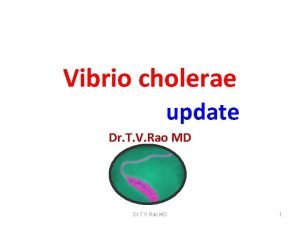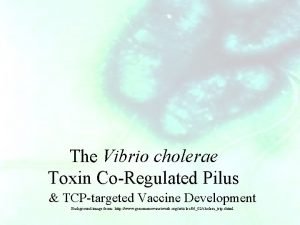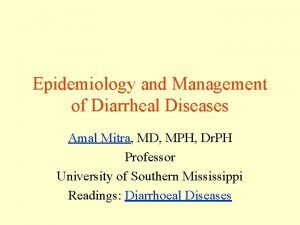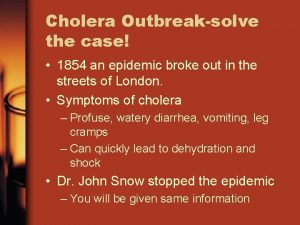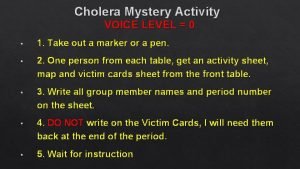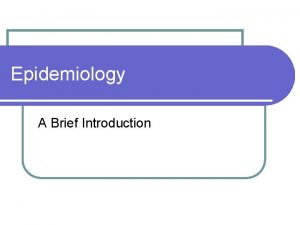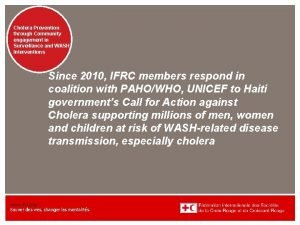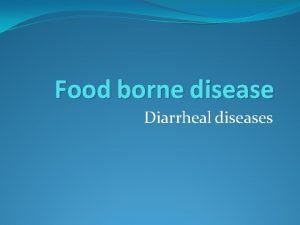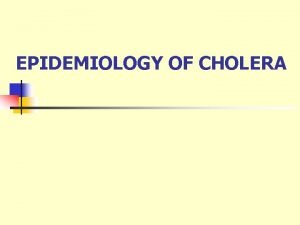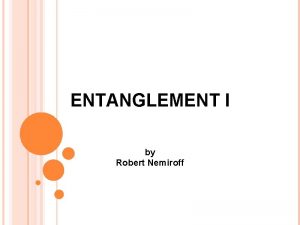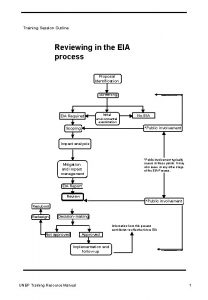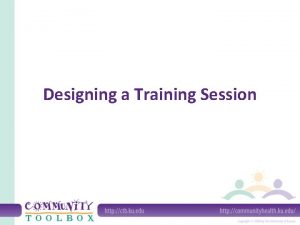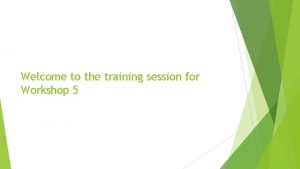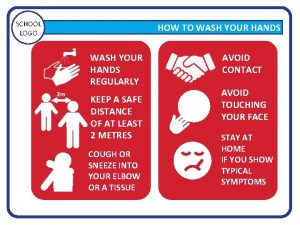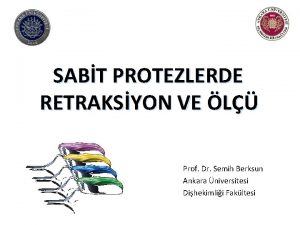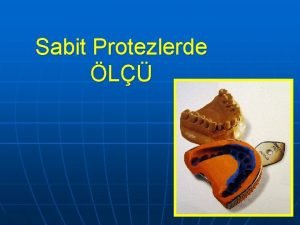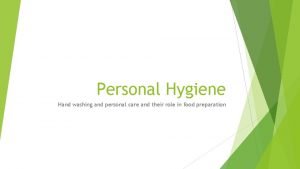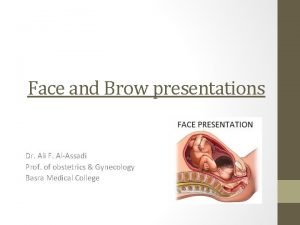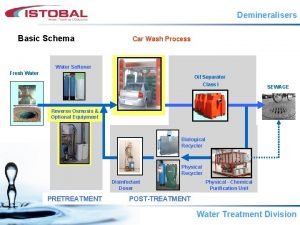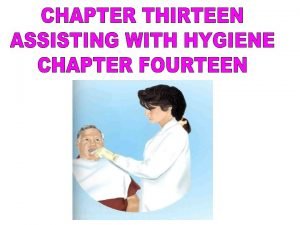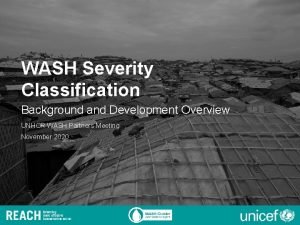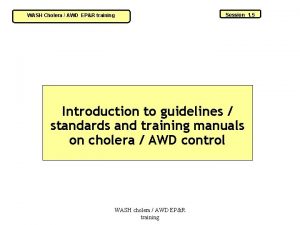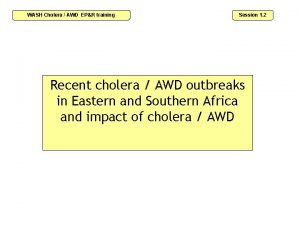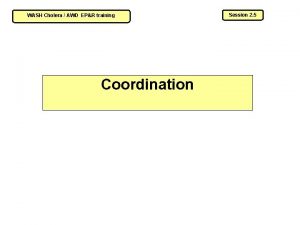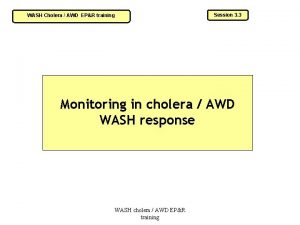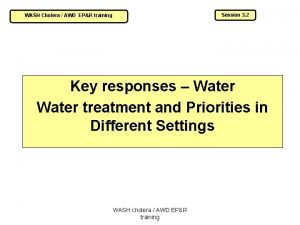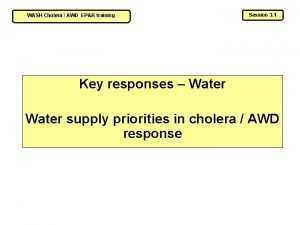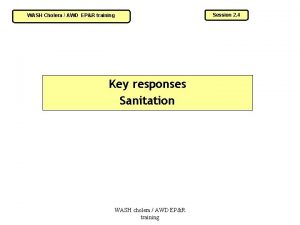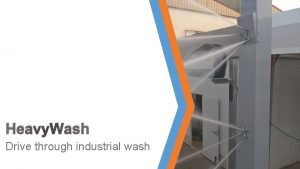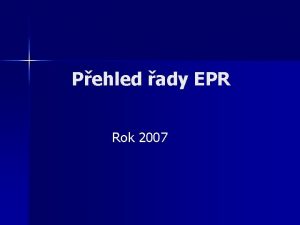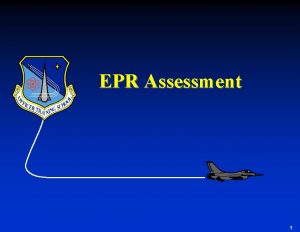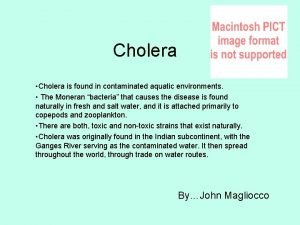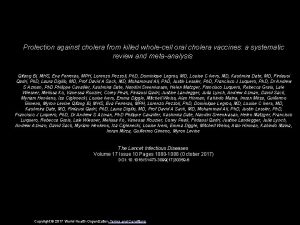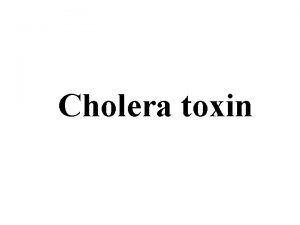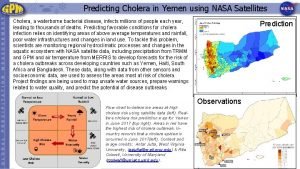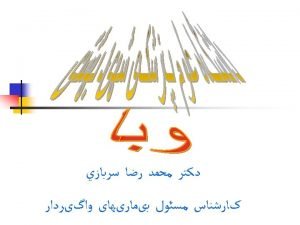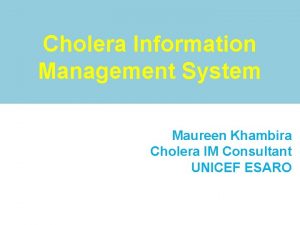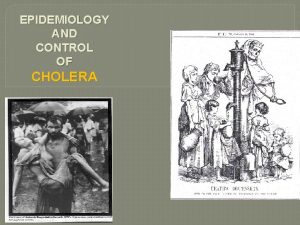WASH Cholera AWD EPR training Session 3 4














































- Slides: 46

WASH Cholera / AWD EP&R training Session 3. 4 Role of WASH in Management of cholera / AWD WASH cholera/AWD EP&R training

Learning objectives By the end of the session the participants will be able to • identify criteria for opening, relocating and closing cholera/AWD treatment facilities. • describe water, hygiene and sanitation requirements within cholera/AWD treatment facilities and identify appropriate technology choices and approaches. • list standard chlorine solutions and their uses for disinfection within cholera/AWD treatment facilities WASH cholera/AWD EP&R training

Management of Cholera - Reducing Mortality • Interventions to reduce mortality aim at providing early rehydration treatment and the organisation of cholera treatment facilities, their location and staffing are all based on this principle. • Cholera is an emergency – treatment facilities must be set up rapidly. • Flexibility is key as the epidemic progresses – facilities must be rapidly multiplied or relocated as the situation evolves. • Cholera is highly contagious – patients must be isolated and infection control procedures put in place. WASH cholera/AWD EP&R training

Cholera Treatment Facilities - Definitions • Cholera Treatment Centres (CTC) and Units (CTU) are inpatient structures where severe cases are isolated and receive specialised care, including IV rehydration. • Oral Rehydration Points (ORP) or ORS Corners are simple structures that provide oral rehydration to moderate cases and refer severely dehydrated patients to CTC/CTU. WASH cholera/AWD EP&R training

Locating Cholera Treatment Facilities • The number of cases per location will determine priority areas where treatment facilities will be set up. • CTC are placed at central level while CTU are smaller, decentralised facilities. • ORP are decentralised and widespread to provide early rehydration for moderate cases and identify severe cases for quick referral to CTC/CTU. WASH cholera/AWD EP&R training

In rural settings multiple, decentralised CTUs are recommended to increase coverage and access. WASH cholera/AWD EP&R training

In urban settings & refugee camps it is preferable to have one single CTC and several ORPs. WASH cholera/AWD EP&R training

ORPs can be decentralised to the community level. WASH cholera/AWD EP&R training

Estimating the Capacity of Cholera Treatment Facilities Rough ‘standard’ figures are used at the beginning of an epidemic in planning interventions [MSF]: Location Estimated AR Peak No. Cases During Peak Av. Length of Stay % Severe Cases (of those coming to CTC) Refugee Camp / Slum District Town / Rural Area 5% 1% Week 3 -4 Week 6 -10 30% 10 -30% 2 days 3 days 75% These first estimates are based on high AR and high proportion of severe cases and must then be adapted to each specific situation. WASH cholera/AWD EP&R training

Using Existing Building for CTC/CTUs Building Type Advantage Disadvantage Existing Health Facility Location is known by patients Staff available Concrete floor Disruption to normal health service function Isolation from other patients difficult or impossible Temporary Structure (to construct) Location is adapted to suit situation Time to construct Tents Location is adapted to suit situation – isolation possible Easy to add extra capacity Hot No concrete floor Hygiene can be difficult to maintain School Large capacity Easy to adapt, separate rooms Education is blocked Warehouse Large capacity Easily adaptable & available Poor ventilation – very hot No partitions, no light Private House Small Close to other buildings Last choice WASH cholera/AWD EP&R training

Structures for Cholera Treatment Facilities Source: MSF WASH cholera/AWD EP&R training

Structures for Cholera Treatment Facilities Source: MSF WASH cholera/AWD EP&R training

Criteria for Site Selection Health Authorities & communities should be actively involved in site selection and the following criteria considered: • Position – look for high ground with good drainage • Distances – other buildings 100 m, water sources 40 m, markets 100 m • Access – vehicle access for materials delivery • Space – consider needs for future expansion, • Floor - concrete preferable, if a temporary structure can use plastic sheeting • Ventilation & Light WASH cholera/AWD EP&R training

Design of Cholera Treatment Facilities Organisation & design of treatment facilities are based on two key principles: 1. Isolation of the entire facility from other public structures such as schools, health services and markets. 2. Separation of patients (contaminated area) from the ‘neutral area’ (not contaminated). WASH cholera/AWD EP&R training

Simplified Design of CT Facilities WASH cholera/AWD EP&R training

Group Work In your groups consider the given scenario and design the layout of a CTU of the specified capacity, considering isolation & patient flow. Draw a plan of the layout. Indicate the type of building selected. 15 min WASH cholera/AWD EP&R training

Water Supply Principles & Standards Water Quantity • CTC/CTU – 60 litres/patient/day + 15 litres/carer/day • ORP – 10 litres/patient/day Water Storage • Ideally, sufficient for 3 days, but as a minimum 1 day Water Quality (for consumption) • Residual chlorine 0. 5 mg/l (p. H<8) • Turbidity <5 NTU (up to 20 NTU in initial emergency phase) WASH cholera/AWD EP&R training

Calculation exercise in plenary Let’s estimate the water supply & storage requirements for your given scenario. WASH cholera/AWD EP&R training

Hygiene Principles • Movement through the facility should be strictly controlled. • Disinfection of shoes/feet and hand washing should take place on all entry and exit points to the facility and between different areas. • Strict disinfection procedures should be followed throughout the facility. WASH cholera/AWD EP&R training

Entry to a CTU WASH cholera/AWD EP&R training

Chlorine Solutions & Cleaning Equipment WASH cholera/AWD EP&R training

Spraying at CTC Entrance WASH cholera/AWD EP&R training Source: MSF and OGB

Sprayers & Footbaths • Sprayers or footbaths are compulsory on the entry-and-exit route between the different areas of the CT facility to ensure disinfection of shoe soles & feet. • Footbaths are rather inefficient as they become dirty very quickly • Sprayers or footbaths can also be an important psychological barrier between the facility and outside. • Both use a 0. 2% chlorine solution. • Staff should be equipped with boots to avoid the irritation caused by repeated contract with chlorine. WASH cholera/AWD EP&R training

A word about spraying of patient’s houses To spray or not to spray? No scientific proof either way + Can be used as an access to further investigate the epidemic e. g. common causes / risks among the households affected / sprayed - Logistically challenging - Can increase stigma WASH cholera/AWD EP&R training

Guard and hand washing facility at exit Hand-washing facilities should be available throughout the CT facility, in all patient treatment areas, and at latrines, footbaths, the kitchen, mortuary and waste area. Hand-washing should be done with a 0. 05% chlorine solution WASH cholera/AWD EP&R training

Bathing WASH cholera/AWD EP&R training

Bathing Areas Use Ratio Minimum Patients / Carers 1: 50 2 showers (m/f) in each area (observation, wards, recovery) - 2 showers (m/f) Staff: Neutral Area • Patient showers should be big enough for 2 persons – carer & patient • A concrete slab or plastic sheeting floor covering are more functional than a layer of gravel as they are easier to clean & disinfect • Showers should drain to a soakaway within the CT facility. WASH cholera/AWD EP&R training

Laundry Areas WASH cholera/AWD EP&R training

Laundry • A laundry should be set up to wash all soiled items from the facility, including blankets, gowns and protective clothing. • Where sinks are not available, large plastic tubs can be used. • Laundry should be immersed and disinfected first in a 0. 2% chlorine solution for 10 min, then washed as usual and hung to dry. WASH cholera/AWD EP&R training

Cleaning the CT Facility • Ideally floors should be made of concrete, or covered in plastic sheeting, for ease of cleaning. Floors in the wards should be mopped with a 0. 2% chlorine solution up to 4 times a day. • Cholera beds should be sprayed with a 0. 2% solution as appropriate and between each occupancy. • Latrines should be cleaned several times a day with a 0. 2% solution, either mopped or sprayed. WASH cholera/AWD EP&R training

Chlorine Solutions Standard chlorine solutions used for disinfection within cholera treatment facilities: Solution Utilisation Storage Period 0. 05% Disinfection of skin, mainly hand-washing One day 0. 2% Disinfection of floors, walls, beds, stretchers, clothes, eating utensils, and vehicles (spray) Spraying latrines Foot sprayers & footbaths One day 1. 0% Mother/Stock Solution For potable water treatment One week 2. 0% Disinfection of patient’s stools and vomit Dead bodies One week WASH cholera/AWD EP&R training

Protective Clothing • Staff should be provided with protective clothing, including boots and overalls. • Gloves should be available for those in contact with blood, chlorine or chlorine solutions. • Gowns or clothes should be made available to patients on hospitalisation, after bathing. WASH cholera/AWD EP&R training

Promotion of Hygiene in the CTC or CTU The organisation of a CT facility is based on a set of actions (disinfection of hands, feet, stools, etc. ), that are simple, but often new for patients and carers who just stay for a short time. These new actions need to be assimilated and put into practice quickly by new arrivals. Hence it is recommended to: 1. 2. 3. Equip the facility in such a way to make actions automatic or compulsory Inform staff, patients & carers of the reason for, and nature of, the actions Monitor and make actions compulsory WASH cholera/AWD EP&R training

Group Work Groups 1 & 3: consider the important hygiene practises which should be promoted to staff, patients & carers regarding activities within the CTU. How could this be done? Groups 2 & 4: consider the important hygiene practises which should be promoted to patients and carers, just prior to discharge. How could this be done? WASH cholera/AWD EP&R training

Sanitation Principles & Standards Excreta Disposal Area Ratio Minimum Patients: Observation, screening, recovery 1: 20 2 toilets (m/f) Patients: Wards 1: 50 2 toilets (m/f) - 2 toilets (m/f) Staff: Neutral Area In addition, provide buckets for all cholera beds & some in observation. Contents should be disinfected prior to disposal. Either place 1 cm of 2% solution in the bucket before use and then empty into the toilet or latrine, or construct an excreta disposal facility specifically for the disinfection & emptying of buckets. WASH cholera/AWD EP&R training

Excreta Disposal Methods • Excreta Disposal Pit – specifically for the emptying of buckets. First disinfect stools and vomit in a 2% solution for 20 -30 minutes in a plastic barrel prior to emptying in the pit. • Temporary Simple Latrines – for staff, carers and patients in the convalescent phase. • Existing Facilities – not ideal but sometimes necessary. Patients’ stool should be disinfected prior to emptying into toilets. Toilets connected to a sewer network should never be used directly by patients. WASH cholera/AWD EP&R training

Temporary Latrines WASH cholera/AWD EP&R training

Sanitation (cont) Waste Water • All waste water from showers, laundry, kitchen, etc can be considered contaminated and should treated in CTC. • Rainfall run-off may contain some contamination but is considered low risk, so may therefore be collected and, where possible, drain out to an existing drainage system. WASH cholera/AWD EP&R training

Sanitation (cont) Vector Control In areas where vector transmitted diseases exist and are of concern, appropriate vector control measures may include: • general hygiene measures (e. g. cleanliness, washing & exposure of bedding to direct sunlight) • prevention of breeding or elimination of breeding sites (e. g. effective excreta disposal, solid waste management, waste water management) • other methods such as indoor residual spraying or flytraps. Note: the use of bed nets is not appropriate in CTC & CTUs WASH cholera/AWD EP&R training

Mortuary • In CTCs a mortuary should be constructed near to the waste zone. It should have an entrance from inside the CTC and access from outside to collect the body. • A closed tent can be set up as a temporary mortuary. Whatever structure is used it should enable effective cleaning inside, with drainage channels that flow into a soakaway pit (body fluids are likely to be highly contaminated). • In CTUs, there may not be the possibility to build a mortuary, in which case rapid burial should be promoted. WASH cholera/AWD EP&R training

Management of Dead Bodies • The body should be moved to the mortuary as soon as possible as fluids will start to evacuate the body • Disinfection of the body should be done inside the mortuary, with 2% chlorine solution • Where body bags are available, they should be used to transport the body for burial. If not available, the body can be wrapped in a sheet soaked in 2% chlorine • Where many bodies must be stored, quicklime (calcium oxide, Ca. O) can be used to neutralise liquids and reduce odours. WASH cholera/AWD EP&R training

Group Work Locate sanitation, waste management and mortuary facilities on your existing CTU layout. WASH cholera/AWD EP&R training

Sanitary Staff • Sanitary staff include supervisor, cleaners, sprayers/watchmen, chlorinator, laundry workers and mortuary workers. • Staffing levels depend on the size of the facility but can be significant – e. g. CTC with 300 patient capacity with 67 sanitary staff on start up and 118 at epidemic peak. [ACF] • Even if there has been cholera preparedness in recent months, training will need to be conducted for all staff. WASH cholera/AWD EP&R training

Closing Cholera Treatment Facilities • The key indicator is when the number of patients is small enough that patients can be treated in separate wards within the existing health structures. Managerial factors to consider include: • possibility of integration of remaining cholera patients into a regular health structure, • possibility to isolate patients, • adequate staffing in the health structure. WASH cholera/AWD EP&R training

Water, Hygiene & Sanitation in Cholera Treatment Facilities Sources of Information: • National Standards or Guidelines • MSF – Cholera Guidelines, 2004 • ACF – Water, Sanitation & Hygiene for Populations at Risk, 2005 • SPHERE – Humanitarian Charter & Minimum Standards in Disaster Response, 2004 • WHO – Guidelines for Drinking Water Quality, 2004 WASH cholera/AWD EP&R training

Learning objectives By the end of the session the participants will be able to • identify criteria for opening, relocating and closing cholera/AWD treatment facilities. • describe water, hygiene and sanitation requirements within cholera/AWD treatment facilities and identify appropriate technology choices and approaches. • list standard chlorine solutions and their uses for disinfection within cholera/AWD treatment facilities WASH cholera/AWD EP&R training
 Selective medium for vibrio cholerae
Selective medium for vibrio cholerae Cholera classification
Cholera classification Types of cholera
Types of cholera Cholera toxin
Cholera toxin Cholera
Cholera Solve the baltimore cholera mystery puzzle
Solve the baltimore cholera mystery puzzle Cholera outbreak malaysia
Cholera outbreak malaysia Cholera
Cholera Epidemiological triad of typhoid fever
Epidemiological triad of typhoid fever Concept of epidemiology
Concept of epidemiology Cholera
Cholera Cholera
Cholera Severe dehydration
Severe dehydration Cholera is a greek word that means gutter of roof
Cholera is a greek word that means gutter of roof Quantum teleportation
Quantum teleportation Targeted delivery
Targeted delivery Epr example
Epr example Qa epr bullets
Qa epr bullets Epr sue jennings
Epr sue jennings Epr cms
Epr cms Epr einstein podolsky rosen
Epr einstein podolsky rosen Epr enterprise
Epr enterprise Epr paradox
Epr paradox Epr.ulaanbaatar
Epr.ulaanbaatar Epr paradox
Epr paradox Epr olkiluoto
Epr olkiluoto Training session outline
Training session outline Facilitate learning session
Facilitate learning session Training session design
Training session design Welcome to the training session
Welcome to the training session Talk boost tracker
Talk boost tracker Opening prayer for training session
Opening prayer for training session Yes clean your room
Yes clean your room Wash in school logo
Wash in school logo Wash ölçü tekniği
Wash ölçü tekniği Eitli
Eitli Hand wash procedure
Hand wash procedure The dishes are washed by my sister
The dishes are washed by my sister Wash fit
Wash fit Car wash payment systems
Car wash payment systems Kasi car wash ideas
Kasi car wash ideas Visit 3. hali
Visit 3. hali Cephalic face wash
Cephalic face wash Car wash water softener
Car wash water softener Cluster wash rdc
Cluster wash rdc Types of bed bath
Types of bed bath Wash severity classification
Wash severity classification
